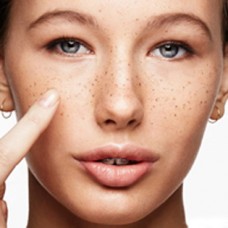Pigmentation on the face, its causes and treatment - these questions concern many. From
pigmentation can be difficult to get rid of. Sometimes it requires serious treatment, in other cases - it passes on its own. It all depends on the reasons for its occurrence.
WHAT IS PIGMENTATION?
Spots on the face appear as a result of exposure to staining pigment cells.
Color is genetically incorporated in man and depends on a combination of yellow, red, brown, blue staining cells.
Melanin (brown pigment) determines the color of the skin and blocks the harmful effects of ultraviolet radiation.
With lighter skin, active manifestations of pigmentation are most noticeable. They can be expressed in the form of freckles, spots, moles. If melanin is deep in the skin, the spots look brighter; if close, they are pale brown in color.

CAUSES OF PIGMENTATION
There are external and internal causes.
Reasons external:
- Active solar radiation. It activates the excessive synthesis of melanin in the deeper layers of the skin. The same reaction may occur when visiting a tanning salon. Particularly often, pigmentation is visible in spring, since during winter the skin loses melanin, and with intense UV exposure, this pigment is produced unevenly.
- Rash. When extruding acne and using a thick layer of poor-quality cosmetics, it is possible the appearance of spots and scars.
- Allergies to food or cosmetics. If time does not remove the rash, peeling, inflammation - dark traces may remain.
- Age pigmentation. After 40-50 years, many pigmented brown color on the hands and face. They spoil the appearance, although not dangerous.
Internal causes:
- Insufficient blood circulation. With stagnation, blood cannot completely eliminate toxins and decomposition products. This is manifested on the skin in the form of age spots.
- Lack of vitamins. Lack of vitamin B12 leads to darkening of the skin (it regulates the production of pigment, which prevents the appearance of new pigment spots). Vitamin E reduces the risk of skin damage from intense exposure to sunlight. Vitamin A brightens the dark shade.
- Slagging of the intestines. It blocks the metabolic processes in the body. As a result, there is a darkening on the skin.
- Gallbladder dysfunction. The liver does not receive the necessary enzymes, resulting in the formation of cholesterol, which leads to clogged blood vessels and impaired lipid metabolism. As a result, pigmentation appears.
- Long-term use of certain medications. In some places, the skin may become darker.
- Diseases of the nervous and cardiovascular systems, especially at the age of more than 40 years. The appearance of yellowish brown pigment spots indicates kidney disease.
- Disruption of the hormonal balance in the body during pregnancy and childbirth, problems with the thyroid gland, gynecological diseases leads to the appearance of pigmentation.
- Stressful condition. If you are stressed for a long time, pigmentation may occur. In this case, you need to put in order your psychological state.
- The causes of pigmentation can sometimes be identified by their appearance. Brown pigment spots can talk about liver disease, gall bladder. Reddish color - the intestine does not work well. Light spots on the cheeks with a yellow tint - possible renal failure.
When the skin is prone to strong pigmentation during the active sun period, it is necessary to protect the face, shoulders and arms with special means.
TYPES OF PIGMENTATION:
Birthmark - a small benign neoplasm.
Freckles - a slight darkening, more pronounced under the influence of the sun. With age, they usually become smaller. It is recommended to use sunscreen or other SPF products to protect yourself from the appearance of new freckles.
Lentigo - this is dark brown spots that appear on the face from the action of ultraviolet radiation. Often found in adulthood.
Vitiligo - white spots that appear due to a violation of the formation of melanin. The propensity for the disease is inherited.
Chloasma - pigment formations that appear when hormonal changes change (pregnancy, gynecological diseases, endocrine dysfunction). Requires treatment.
To eliminate the problem of pigmentation as much as possible more effectively - you need to establish the causes of its occurrence. It is best to contact an experienced specialist.


